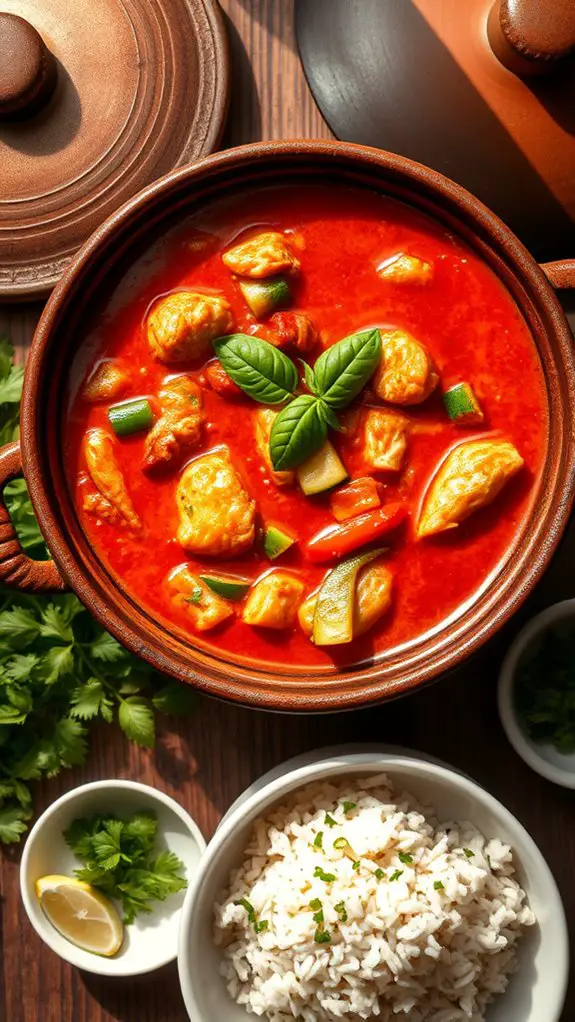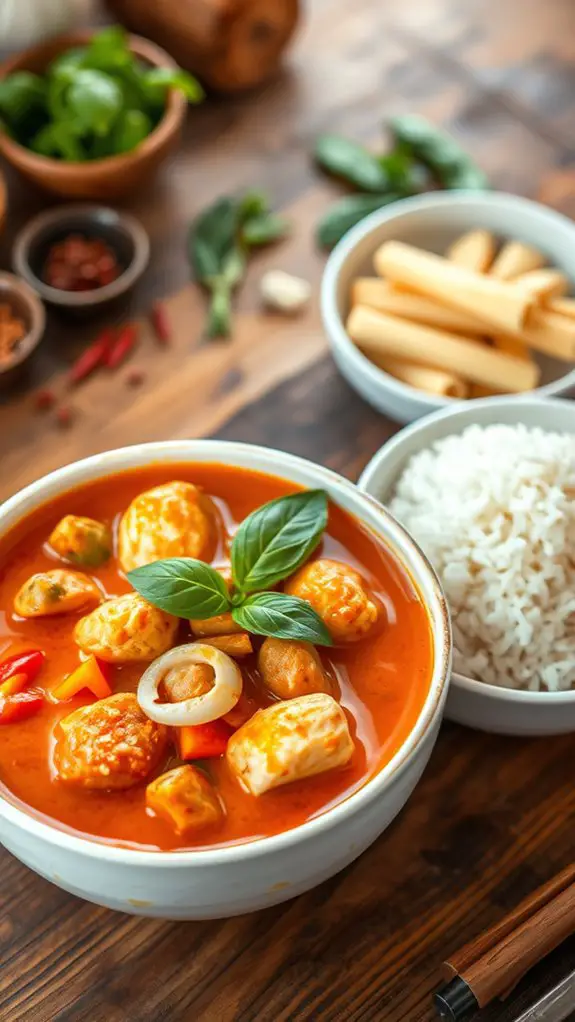Did you know that red curry is one of the most popular Thai dishes, with over 60 million servings consumed globally each year? It's no wonder, given the vibrant flavors and versatility of this rich, aromatic dish. Discover how to craft your own version at home, opening up a world of culinary delight and nutritional benefits.
History

Although the origins of red curry can be traced back to Thailand, the dish has since evolved and been adapted across Southeast Asia.
Thai origins of the fiery, coconut-based curry date back centuries, with the earliest known recipes appearing in ancient palace cookbooks.
Over time, regional variations emerged as the dish spread, incorporating local ingredients and cooking techniques.
Today, you can find countless iterations of red curry, each with its own unique flavor profile shaped by the culinary evolution of the region.
From the aromatic versions in Malaysia to the sumptuously thick renditions in Indonesia, red curry's versatility has solidified its status as a beloved Southeast Asian staple.
Recipe

Red curry is a fragrant and flavorful Thai dish that's easy to prepare at home. The creamy coconut milk base is balanced by the heat of red curry paste, creating a deeply satisfying meal. This recipe will guide you through the steps to create an authentic and delicious red curry.
Red curry is a versatile dish that can be made with a variety of proteins, from chicken to shrimp to tofu. The key to a great red curry is using high-quality ingredients and taking the time to develop the flavors.
- 1 tablespoon vegetable oil
- 2-3 tablespoons red curry paste
- 1 (13.5 oz) can coconut milk
- 1 lb boneless, skinless chicken breasts, cut into bite-sized pieces
- 1 cup sliced bell peppers
- 1 cup sliced onions
- 2 tablespoons fish sauce
- 1 tablespoon brown sugar
- 1 cup coconut milk
- 1 cup chicken broth
- Fresh basil leaves for garnish
In a large skillet or wok, heat the vegetable oil over medium heat. Add the red curry paste and cook for 1-2 minutes, stirring constantly, until fragrant.
Slowly whisk in the coconut milk, scraping up any browned bits from the bottom of the pan. Bring the mixture to a simmer and add the chicken, bell peppers, and onions.
Simmer for 10-15 minutes, or until the chicken is cooked through and the vegetables are tender. Stir in the fish sauce and brown sugar, and taste for seasoning, adding more as needed.
Finish by stirring in the additional coconut milk and chicken broth, and let the curry simmer for 5 more minutes to allow the flavors to meld.
To guarantee the best results, use high-quality red curry paste and full-fat coconut milk. You can also adjust the amount of curry paste to suit your desired level of spiciness.
Serve the red curry over steamed jasmine rice and garnish with fresh basil leaves.
Nutritional Guide
This red curry dish offers a nutritional profile that can contribute to a well-balanced diet.
The robust flavor profile of red curry, including aromatic spices and coconut milk, provides a range of health benefits. The ingredients are rich in vitamins, minerals, and antioxidants that can support immune function, cardiovascular health, and reduce inflammation.
The combination of protein, complex carbohydrates, and healthy fats in this dish promotes satiety and stable blood sugar levels.
Incorporating this nutritious red curry into your meal routine can be a delicious way to nourish your body and support overall wellness.
Final Thought
Incorporating this nutritious red curry into your regular meal rotation can be a delicious way to nourish your body and support your overall wellness.
The harmonious blend of aromatic spices in this recipe, like lemongrass, galangal, and kaffir lime, create a complex and flavorful dish.
The versatility of red curry allows you to experiment with various protein sources, vegetables, and serving suggestions to suit your taste preferences.
Whether you enjoy it over steamed rice, with roasted vegetables, or alongside fresh herbs and a crisp salad, this vibrant dish is sure to become a staple in your culinary repertoire, promoting both your physical and holistic well-being.